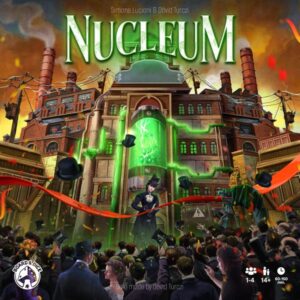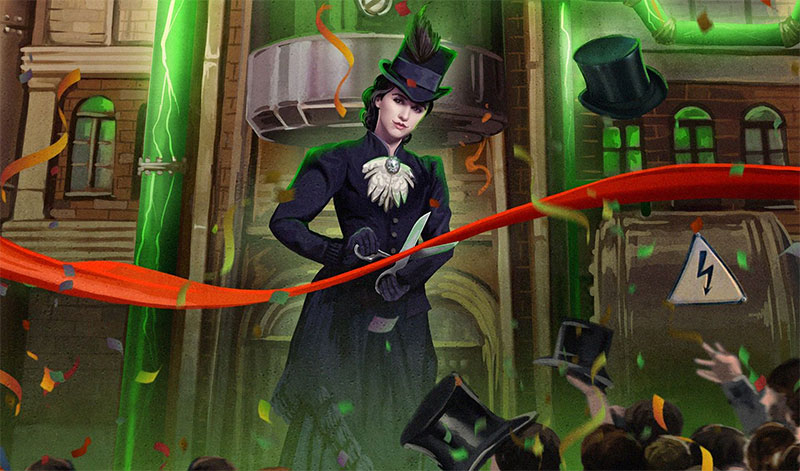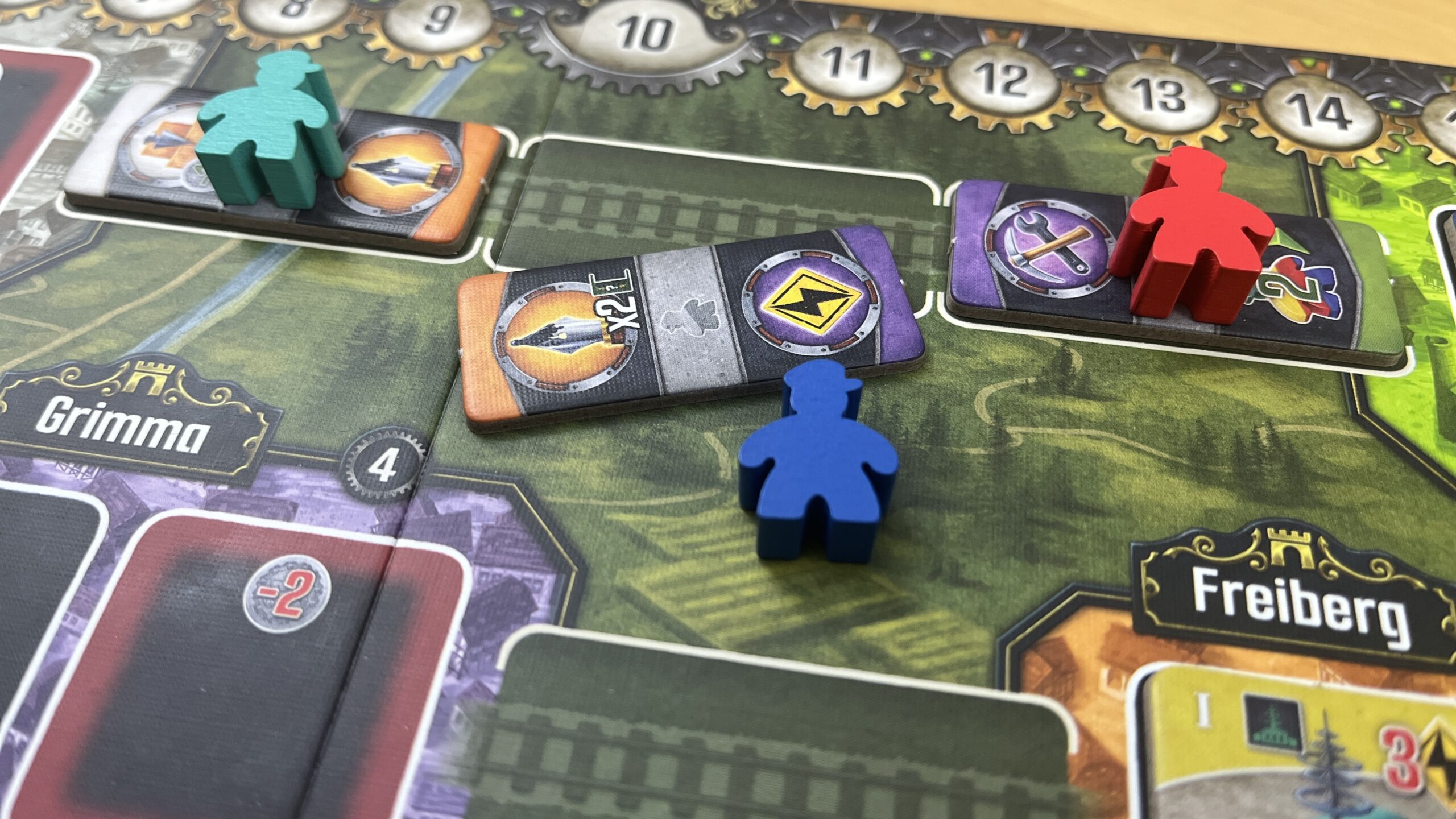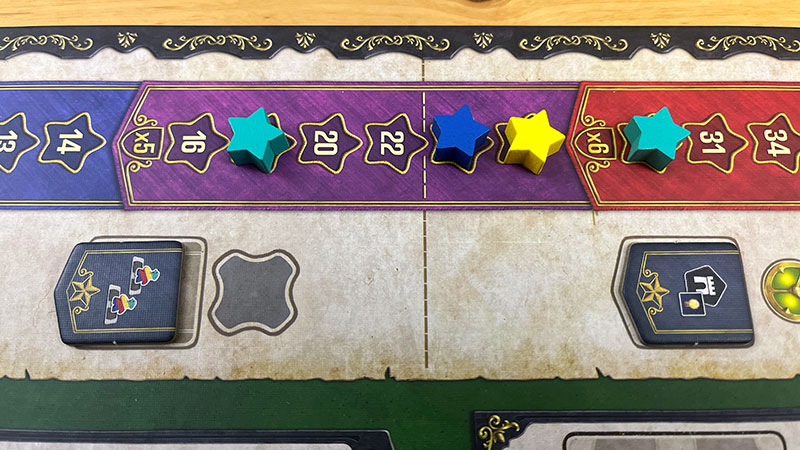When it comes to giving me board games, Santa’s no slouch. He just seems more optimistic than i am about how much time i have to sit down and enjoy myself. My copy of On Mars: Alien Invasion that i received two Christmases ago is still in shrink, and the Christmas before that, On Mars itself sat lonely and unfondled until well into summertime. But i was determined not to make the same mistake with my hot fresh copy of Nucluem, the only game i could think to request for my birthday this past December 1st. Truth be told, my board game collection is piling up in Seussian stacks that zam and zum-zag all over my basement, so i am much choosier about what i permit past my doors these days. To borrow a Seinfeldism, if i’m going to add a game to my collection, it has to be sponge-worthy.
Nucleum, the latest effort from the increasingly can’t-miss publisher Board & Dice, has a powerful pedigree: its designer is Simone Luciani, whose past titles like The Voyages of Marco Polo and Tzolk’in: the Mayan Calendar i count among some of the best games i’ve ever played. But other titles of Luciani’s, like Lorenzo Il Magnifico and Darwin’s Journey i’m not as enamoured with (to be fair, i’ve only played Lorenzo at 2, and found it oppressively tight, but i’ve been told it’s better at higher player counts). Luciani’s co-designing partner in crime (and i do mean crime) is David Turczi, who i’ve come to learn, after careful research and consideration, is a punk.
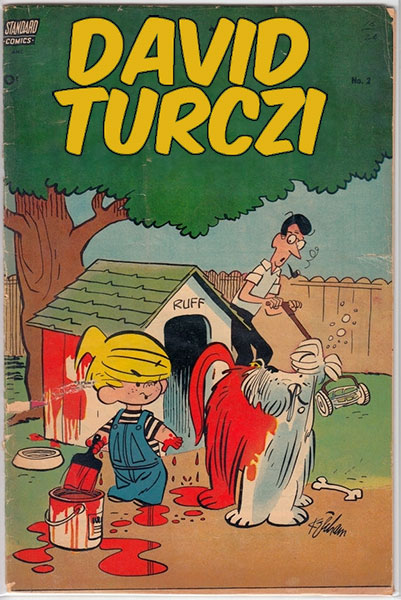
Pictured: designer David Turczi, up to his usual hooliganism.
Tastes Like Char and Worker Exploitation
One of Luciani’s other well-known titles is Barrage, which i gather is about early 20th century industrialists trying to… do something with water? Or oil? i’m not sure. But reviewers before me have called Nucleum the love child of Barrage and non-Luciani game Brass: Birmingham. i did get a chance to play that one, another grimy-looking game about 19-something industrialists trying to twirl their moustaches the hardest in order to crush the proletariat and blanket the planet in soot. It’s not a theme i generally go for; Carnegie sat on my shelf for the better part of a year, because i’m just generally not enthused to play out the Great Man fallacy/fantasy in my free time.
It’s about the guy who wrote How to Win Friends and Influence People, right? …R-right?
It was the same with Nucleum. Here was a dirty, greasy board of greys and greens festooned with railroad tracks, hinting at a certain flavour of steampunk sci fi without fully delivering. The Willemina Wonka-esque figure on the front of the box wears a Victorian stovepipe hat, which i can get behind, and Nucleum supposedly takes place in an alternative past where nuclear power supplanted coal half a century early. But it’s a pretty tame “what if” scenario when compared with something like Scythe‘s marauding mechs bending ploughshares back into swords across a war-ravaged fake Europe. The whole thing starkly recalled Power Grid. And i’m no fan of Power Grid.
As it happens, Nucleum’s cover art represents the extent of its theme and storytelling. The designers needed something, and it was either this or baking buns in a Bavarian bistro. The rest is pure gameplay. (Kudos to Luciani and Turczi for not blindly picking an exotic-sounding ethnic group at random out of an anthropology textbook… a degree of restraint that doesn’t seem like it should warrant any back-patting, but if you know board games, you’re aware that the bar’s pretty low.)
Burning the Actions at Both Ends
The game gives you a handful of double-ended action tiles, not unlike dominos, that may remind you of the action tiles from games like Praga Caput Regni. The difference here is that on your turn, you can play your tile to one of the finite slots at the top of your player board and take both actions (where Praga limits you to taking just one). The actions include constructing one of your building tiles on the communal board (which recalls Great Western Trail), buying additional tiles, taking a contract (hello, Voyages of Marco Polo), building a turbine or uranium mine, or firing up a nearby coal plant to power one of the buildings you laid down on a previous turn.
Electrifying those buildings is the name of the game. Well… actually, “Nucleum” is the name of the game, and the word refers to a new type of power plant that can burn (get this) uranium instead of coal, cheaper and more efficiently. But a perfect storm of conditions must be met before you can shift your energy production to clean-burning cancer rocks: you need a mine on the map. You need uranium in that mine. You need railroads – yours or others’ – connecting the city containing your mine to the city containing your building. And both must be connected to a city that has a uranium-burning nucleum in it. From the beginning of the game, all power plants can burn coal, but only those power plants that have a big green cube in them can additionally burn uranium. Coal plants upgrade to nucleums (nucleii?) as the game progresses, and at the whim of certain players who trigger certain actions at certain times.
It’s all very Lacerdian in its circular requirements. Like Vital Lacerda’s On Mars, Nucleum is the board game equivalent of needing experience to get a job, and needing a job to get experience. It gets downright tricky when you’re faced with the decision to play one of your dominoes to the top of your personal board, or forfeit it forever by placing it as a railroad track on the common board. There are only five actions in the game, as were mentioned, and your starting hand of tiles features all of them. But relinquishing one or more of your tiles (and a little worker meeple to boot) in order to connect more cities to expand your network means depriving yourself of that action in the future, unless and until you can buy another copy of it at market. But what happens if you convert your only “buy a market tile” tile to a railroad? Thankfully, you have a failsafe tile with a single “any action” icon on it that you’re not allowed to bind to the board.
If you manage to match the colours of one or both ends of the tile you lay as a railroad track to the colours printed on the board, you get to perform those actions from the tile. So it’s nearly as good as playing the tile to your personal board (except that you lose it forever!) But some railroads accommodate two, or even three, railroad tiles, so you may find yourself bumping up against your opponents and providing them with free actions, if one side of your domino’s colour matches theirs.
It’s Now or Never
One of the most interesting mechanics in the game is the notoriety track. During play, you earn star tokens, mostly for powering up your buildings. On your turn, in addition to playing a tile to your own board or the common board, you can alternatively take a rest action to reclaim your (non-railroad) tiles and earn some income. This “recharge” action also forces you to spend your stars to place a token on an achievement track. The hitch is that, like the cow-delivery cities in Great Western Trail, you can’t place more than one of your own tokens in the same section of that track. So throughout the game, you’re desperately trying to squeeze just a few more stars from your actions to beat your past personal best, to avoid having to place a token on a lower rung (or, perhaps worse, on the -3 points space at the bottom of the track).
At the end of the game, the tokens you placed along the track score you points multipliers for some randomly-dealt endgame goals, such as the number of factories you’ve built. As this is a dyed-in-the-wool eurogame, points come from plenty of other sources as well: you’ll rack up digits by powering your buildings, being the first to achieve certain endgame triggers, and slamming your most powerful technology widget into place (did i mention each player’s asymmetric list of achievable technologies? They’re a whole thing.)
This 3d printed holster, made to protect the technology tiles from wear, is part of a brilliant Nucleum insert by Thingiverse user mycael
By the end of the whole ordeal (which took my group of four mid-to-heavy gamers almost four hours to get through, which we all decided was “pretty good” for a first play), your brain will be pleasantly irradiated. My wife Cheryl and i had played our very first game a week earlier (to prevent me from getting too thoroughly trounced by my highly skilled and sharky game group); she and i split our play session up across two evenings. Having played Nucleum now at the 2p and 4p player counts, i can confirm the game plays much better, and is more interesting, with 4. That’s usually the case with games where the whole point is to get in each others’ way.
They Don’t Love You Like I Love You
While i did like the game, i will never play Nucleum frequently enough to discover all the pros and cons of the base map. i could sniff out that the top of the board was very powerful, since it connects you almost immediately to a coal plant and, equidistantly, both coal depots. Indeed, the player in our group whose score dominated ours to the point where he nearly lapped the rest of us did so by (among other things) cornering the market on that literal top-left corner of the board. i can already tell, based on the expansion announcement, that the strategy for future iterations of Nucleum is to release additional maps. We’ve seen this approach with series like Concordia, Terraforming Mars, and the aforementioned Power Grid. If multiple maps ain’t your cup of tea, you might not like the direction Nucleum’s headed.
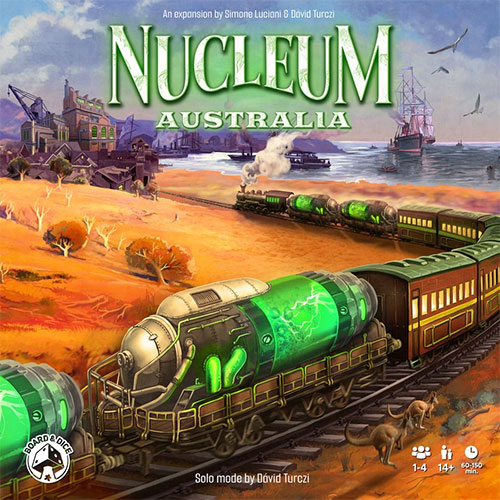
Seems safe.
Despite its paper-thin theming and grotty graphics, Nucleum promises a highly enjoyable evening for players who like their games on the heavier side. Especially in light of our ear-bleedingly complex game of Voidfall a month earlier, i was terrified that i would become catatonic with analysis paralysis during our 4 player session. To the game’s great credit, it went down very smoothly, thanks in no small part to the easily referenced glossary that lays out the function of most of the game’s tiles and contracts. The upcoming expansion, Nucleum: Australia, was a no-brainer pre-order for me, and the fellas all seemed pleased when i told them i had ordered it. Definitely consider adding Nucleum to your collection if you like going to the gym and blasting out reps on your pecs, where “the gym” is the board game table, and “blasting out reps on your pecs” is giving your beloved brain a good workout.
Rules We Got Wrong (So You Won’t Have To)
These were two important rules Cheryl and i botched in our first aborted attempt to play:
- ALL power plants can burn coal, including the ones that have been upgraded to nucleums. ONLY nucleums can burn uranium.
- The buildings, turbines, and mines you lay down must all be within your own network of rail-connected cities (using opponents’ rails only works when you’re transporting coal or uranium to power plants, and when those power plants need to be connected the buildings you’re powering). If you want to sacrifice an action tile to build a rail, you can place that tile anywhere – drop it off on the opposite side of the board, if you want to! You’re not limited to building out your network from its existing core. This isn’t Catan. 🙂

